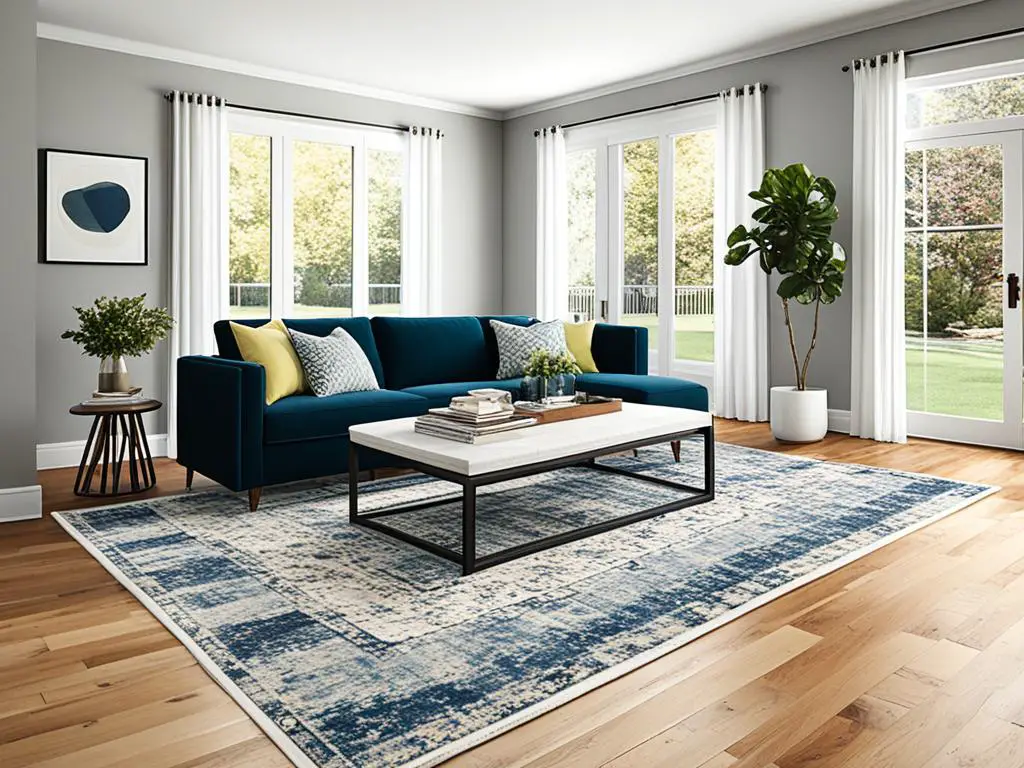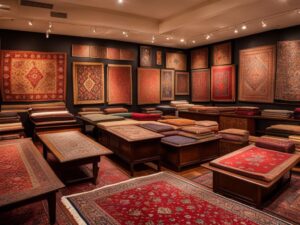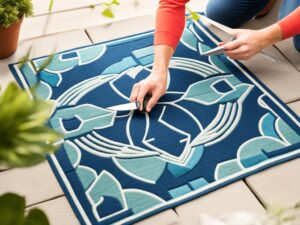When it comes to decorating your space, finding the right rug size is essential. Whether you’re looking to add a cozy touch to your living room or a soft landing in your bedroom, the dimensions of your rug can make all the difference. In this comprehensive guide, we’ll focus on the popular 4 by 6 rug size and provide you with expert tips and insights to help you find the perfect fit for your home.
Key Takeaways
- Understanding the dimensions of a 4 by 6 rug will help you determine its suitability for different areas of your home.
- Consider your design objectives and furniture layout when choosing the right rug size.
- Larger rugs like 8×10 and 9×12 are commonly used in living rooms, with most furniture legs placed on the rug for a cohesive look.
- For smaller spaces, popular choices include 5×8 and 6×9 rugs, which offer flexibility and unique design options.
- Round and runner rugs can add dynamic features to your space, while layering rugs creates a visually appealing effect.
- In bedrooms, choose a rug size that extends beyond the bed to create a soft landing while adding visual interest.
- Remember to consider your personal preferences and the functionality you desire when selecting your 4 by 6 rug.
Understanding Rug Size and Design Objectives
Choosing the right rug size is crucial when it comes to designing your space. It not only affects the overall visual appeal but also contributes to the functionality and layout of the room. A well-selected rug can serve as a focal point, unite different elements, or create separation within a given area.
When deciding on the perfect rug size for your space, consider the following design objectives:
- Focal Point: A larger rug that covers most of the floor can draw attention to the center of the room, creating a captivating focal point. This works well in living rooms or dining areas where you want to highlight the beauty of the rug.
- Accent: A smaller rug placed strategically in certain areas, such as under a coffee table or by the fireplace, can add a touch of style and enhance the overall aesthetic of the room.
- Unite: If you have an open floor plan or multiple seating areas within a room, a sufficiently large rug can help visually connect and unify the different spaces.
- Separate: In contrast to uniting, rugs can also be used to create separation between distinct areas. For example, placing a rug under a dining table can define the dining area within an open concept space.
- Furniture Layout: Consider the placement of furniture when choosing a rug size. Ideally, furniture should either be completely on the rug or partially touching it to create a cohesive and harmonious arrangement.
Rug sizing charts can provide valuable guidance and help you visualize the ideal dimensions based on your room’s measurements. However, it’s important to remember that personal preferences and the specific functionality you desire should ultimately guide your decision.
Remember, the goal is to create a visually pleasing space that reflects your unique style and meets your practical needs.
Examples of Rug Size and Design Objectives
To better understand how rug size and design objectives can work together, take a look at the following examples:
| Design Objective | Rug Size | Placement |
|---|---|---|
| Focal Point | Large | Centered in the living room, covering most of the floor space, with furniture arranged around it |
| Accent | Small | Placed under a coffee table or by a fireplace to add visual interest to a specific area |
| Unite | Large | Extending from one seating area to another, visually connecting the spaces |
| Separate | Medium | Placed under a dining table to define the dining area within an open concept space |
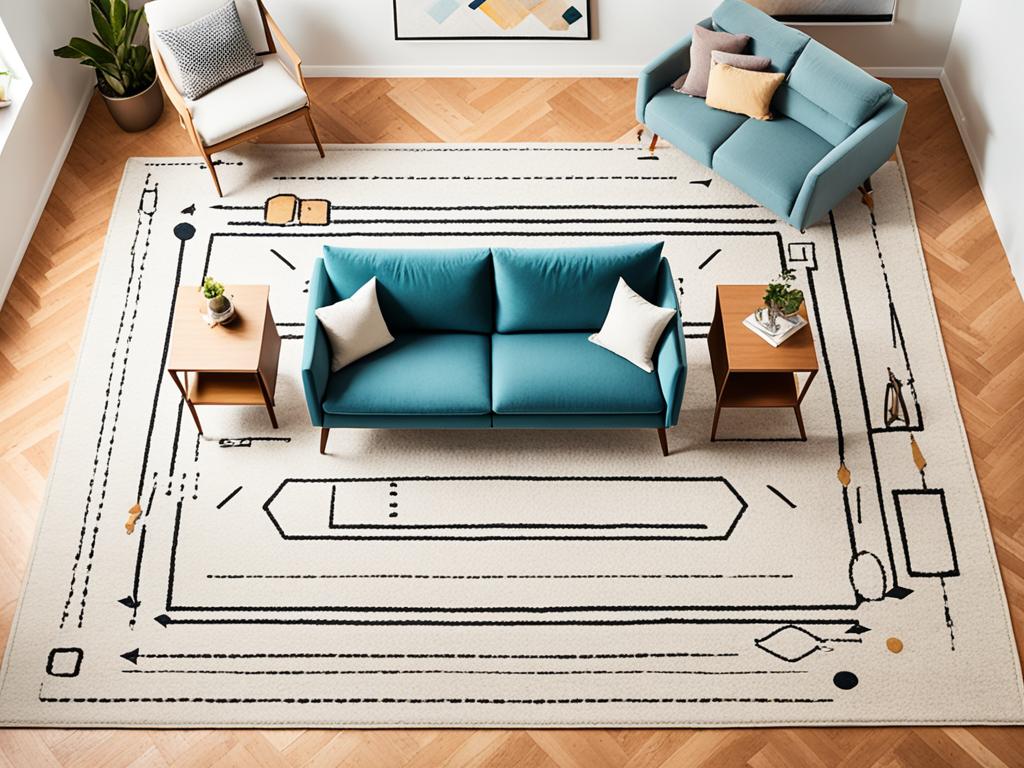
As you can see, understanding the relationship between rug size and design objectives is key to achieving a cohesive and visually pleasing space. Use this knowledge, along with your own personal style, to select the perfect rug that complements your room’s aesthetics and meets your functional needs.
Standard Setups for Larger Rugs
Larger rug sizes, such as 8×10 and 9×12, are popular choices for living rooms and larger spaces. These sizes offer ample coverage and create a sense of presence in the room. In this section, we’ll explore the standard setups for these larger rug sizes and how they can transform your living space.
The All-Furniture-On Setup
One of the most common setups for larger rugs is to have most, if not all, furniture legs placed on the rug. This arrangement defines the designated area and brings all the furniture pieces together, creating a cohesive and visually pleasing design.
The all-furniture-on setup helps to separate the designated area from the rest of the room, creating a clear distinction between different zones within the space.
This setup works well in open-concept living areas where multiple functions are combined in one room. By placing the furniture on the rug, you establish a visual boundary that delineates the conversation area or seating arrangement.
Take a look at the example below to see how an 8×10 rug transforms a living room:
The Partial-On Setup
While the all-furniture-on setup is popular, there are other options to consider based on personal preferences and specific design objectives. One alternative is the partial-on setup, where only a portion of the furniture legs rest on the rug.
This setup offers a more relaxed and casual look, allowing for more creative freedom in arranging furniture. It can work particularly well in eclectic or bohemian-inspired spaces, where mixing and matching different textures and patterns is key.
Exploring Personal Preferences
When deciding on the setup for larger rugs, it’s important to consider your personal preferences and the overall aesthetic you want to achieve. Some homeowners prefer a more traditional and formal look, while others prefer a more contemporary and relaxed feel.
Additionally, certain furniture layouts may require specific rug arrangements. For example, if you have a sectional sofa, you may want to ensure that it is fully placed on the rug to create a unified and balanced look.
To give you a better sense of the possibilities, here’s a comparison table highlighting different aspects of the all-furniture-on and partial-on setups:
| All-Furniture-On Setup | Partial-On Setup | |
|---|---|---|
| Aesthetic | Formal and visually cohesive | Casual and relaxed |
| Function | Clearly defines the designated area | Offers more creative freedom |
| Flexibility | Works with various furniture layouts | Allows for customization |
As you can see, both setups have their own advantages and can complement different design styles. Consider your preferences, the overall aesthetic, and the functionality of the room to determine the best setup for your larger rug.
Popular Sizes: 5×8 and 6×9 Rugs
As people continue to downsize their living spaces, 5×8 and 6×9 rugs have emerged as popular choices. These sizes offer flexibility and unique design options that cater to the needs of smaller homes and apartments.
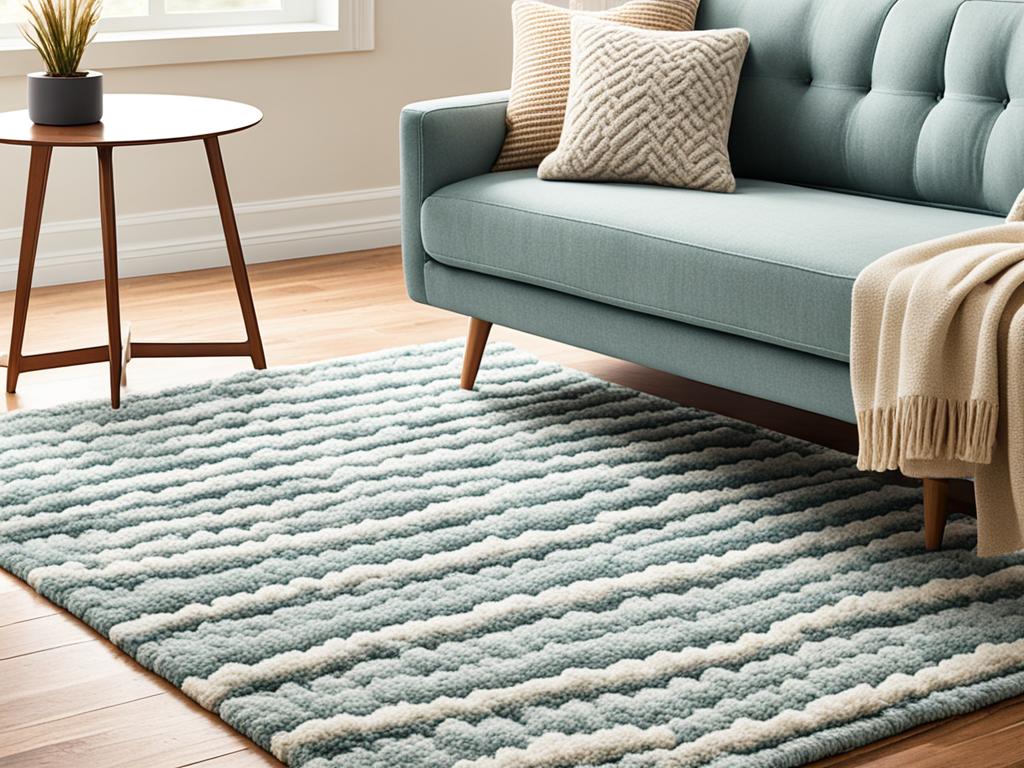
The 5×8 rug size provides a versatile solution for various areas of the home. In a standard setup, the furniture starts to separate itself from the rug, creating a distinct visual appeal. Although rarely used in dining setups due to limited size, a 5×8 rug can be the perfect addition to kitchens, entryways, bathrooms, and other unique spaces.
The slightly larger 6×9 rugs offer increased coverage and can be a great fit for apartment living and smaller living rooms. They provide a comfortable and cozy atmosphere, while still giving sufficient space for furniture arrangements. These rugs add warmth and style to any room without overwhelming the space.
Both 5×8 and 6×9 rugs are well-suited for downsized living spaces, as they maximize the functionality of smaller areas and contribute to a balanced and aesthetically pleasing design. Whether you’re looking to create a cozy nook or define a specific area within a larger room, these popular rug sizes offer the perfect solution.
Round and Runner Rug Options
When it comes to rug choices, round rugs and runner rugs offer unique options for adding visual interest and functionality to your home. Whether you want to mimic the shape of round tables or define narrow hallways, these rug choices can transform your space.
Round Rugs: Adding Dynamic Features
Round rugs are a fantastic choice for mimicking the shape of round tables and adding dynamic features to traditional living room setups. By placing a round rug beneath a round table, you create a visually appealing focal point that draws attention to the table and creates a cohesive design. Additionally, round rugs can also work well in dining areas, provided they are large enough to accommodate all chair legs.
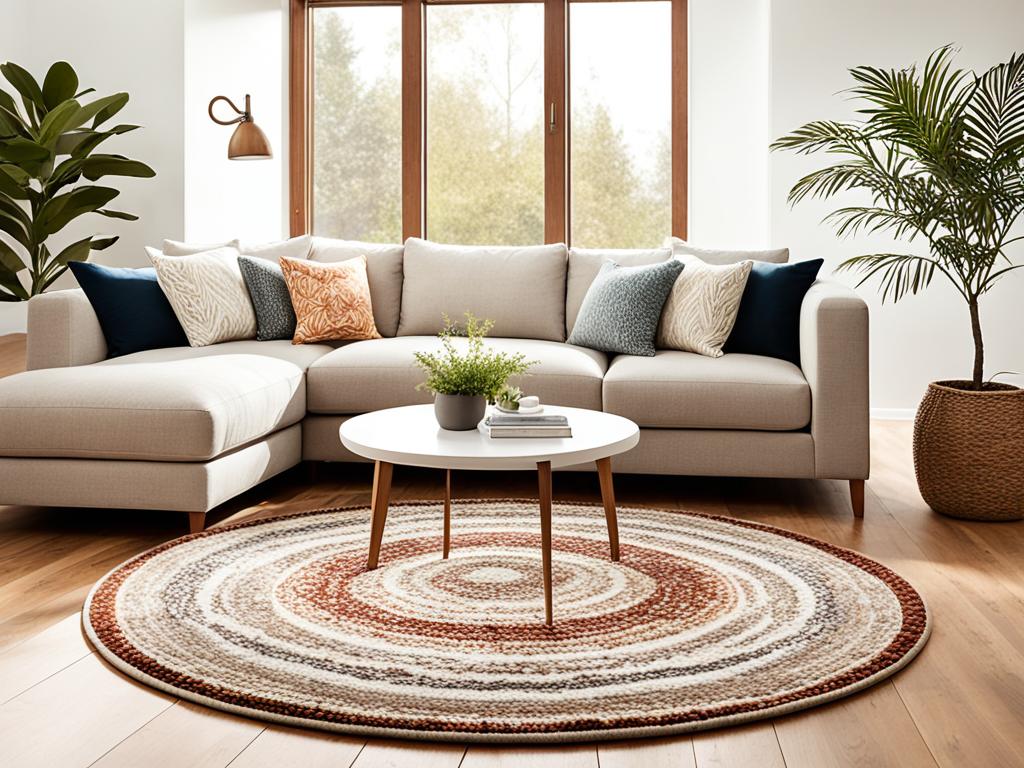
Runner Rugs: Creative Use in Different Spaces
Runner rugs are typically used in hallways or narrow areas of the home to protect the flooring and guide traffic. However, there are creative ways to use runner rugs in other spaces as well. For instance, you can place a runner rug at the foot of a bed to create a soft and cozy landing as you wake up in the morning. Runner rugs can also be layered with larger rugs in living rooms or bedrooms to add texture and depth to the space.
Layering Rugs: A Stylish Design Choice
“Layering rugs of different sizes is an emerging trend in interior design. It allows you to create a unique and stylish look while adding more coverage or fitting a smaller rug into a larger area.”
By layering rugs, you can create a visually interesting and textured look that adds depth to your space. For example, you can place a smaller round rug on top of a larger rectangular rug to create a focal point in a living room or bedroom. Alternatively, you can layer a runner rug on top of a larger area rug to define specific areas within a room or to create a cozy reading nook.
With round rugs, runner rugs, and the option of layering rugs, you have a multitude of choices for adding style and functionality to your home. Consider the shape of your furniture, the size of your space, and your personal design preferences when selecting the perfect rug option for each area of your home.
Rug Size Guide for Bedrooms
In bedrooms, choosing the right rug size is essential for creating a cozy and stylish space. The size of the rug will largely depend on the size of your bed. Whether you have a king or queen bed, here’s a guide to help you find the perfect rug size.
Rug Size for King Bed
For a king bed, it’s important to select a rug that extends at least 2 feet around the bed on all sides. This ensures that the rug frames the bed and creates a balanced look. The rug should also reach the far ends of the nightstands, providing a soft landing when waking up in the morning.
Rug Size for Queen Bed
If you have a queen bed, the rug should cover the area from under the bed to the near edge of the nightstands. This allows for a cohesive and visually pleasing design, with the rug acting as a foundation for the bed. It adds warmth and comfort to the room while complementing the overall decor.
By choosing the right size rug for your bedroom, you can enhance the overall aesthetic and create a luxurious and inviting atmosphere. Now that you know the ideal rug sizes for king and queen beds, you can confidently select a rug that perfectly suits your space.
Explore our table below for a quick reference guide to bedroom rug sizes:
| Bed Size | Ideal Rug Size |
|---|---|
| King | At least 2 feet around the bed on all sides, reaching the far ends of the nightstands |
| Queen | Cover the area from under the bed to the near edge of the nightstands |
Conclusion
Finding the right rug size is crucial for achieving a harmonious and visually appealing design in your space. By considering your design objectives, furniture layouts, and the specific dimensions of the rug you need, you can create a cohesive and inviting atmosphere. A well-chosen rug has the power to enhance the warmth and ambiance of any room, making it a worthwhile investment.
Throughout this rug size guide, we have provided insights and tips to help you navigate the process of selecting the optimal rug fit. However, it’s important to remember that these recommendations serve as a starting point. Feel free to explore and build upon them to create a space that is uniquely yours.
Whether you’re looking for a 4 by 6 rug or considering larger sizes like an 8 by 10 or 9 by 12, taking into account your personal preferences and the functionality you desire will ensure a rug that perfectly suits your needs. Remember that rugs can be used as focal points, accents, and room dividers, allowing you to create a cohesive and visually pleasing design.
As you embark on your rug shopping journey, let this guide be your companion. With the knowledge you’ve gained, you’ll be equipped to find the right rug size for your space, transforming your home into a haven of style and comfort.
